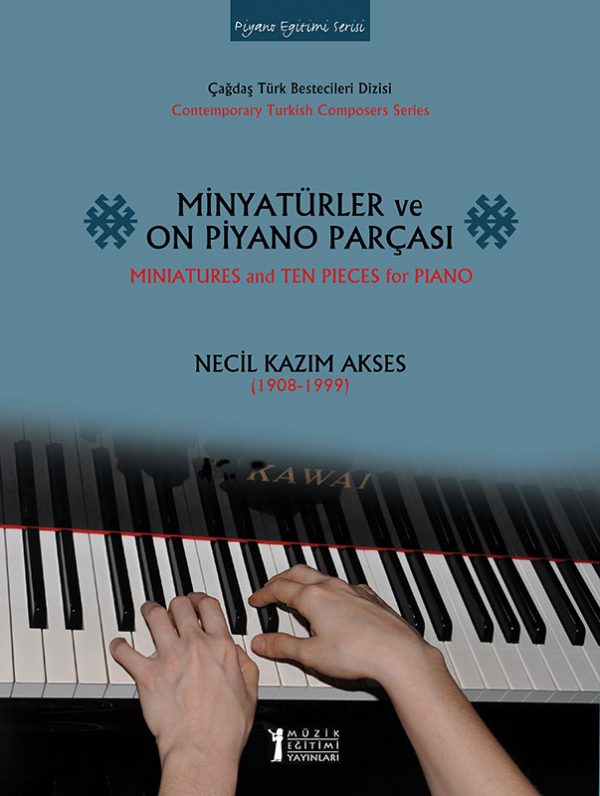
Yazarı: Necil Kazım Akses (1909-1999)
ISBN: 978-605-61557-7-2
Barkod: 9786056155772
Basım Tarihi: Ağustos 2011
Boyutu: 23 x 30.5 cm.
Sayfa Sayısı: 72
Müzik Eğitimi Yayınları No.30
Piyano Kitapları Serisi.05
Fiyatı: 35TL.
Stoktan Hemen Al – MuzikKitaplari.com
Minyatürler
1936 yılında yedi parçalık bir deste olarak yazılan eser, ilk kez ve aynı yıl Jorj D. Papajorjiu tarafından İstanbul’da basılmıştır. Eser Ulvi Cemal Erkin’e adanmıştır. Hem özü hem de biçimi yönünden gerçekten birer minyatür olan parçalar genel olarak ezgi-eşlik durumunun belirgin olduğu “homofonik” yapıdadır. Öte yandan yalın ezgi ve armoni yapısı halk müziği esinlidir. Bu nitelikleriyle Minyatürler; her ne kadar piyano öğrencileri için hazırlanmış gibiyse de resital programlarına alındığında yadırganmadan dinlenebilecek parlak nitelikli parçalardır.
On Piyano Parçası
1964 yılında yazılmıştır. Akses’in olgun armoni mantığında en güzel senteze ulaşan tonalite ve modalite kavramları bu on parçada örneklenmiştir. Ayrıca her parça piyano tekniği açısından değişik bir konuyu içermekte ve bu yönüyle de ayrı bir önem kazanmaktadır. Örneğin 1. parça üç dizekte yazılmıştır. En alt dizekte parça boyunca süren bir basso ostinato vardır. 3. Parça bir sağ elde, bir sol elde gelen onaltılık motiflerle bir moto perpetuo’dur. 5. parça aksak ölçülerde bir çalışma; 7. parça üç sesli bir füg; 8.parça ise yoğun akorlarıyla bir cenaze marşıdır. Bu parçalardaki armonik yapıda en çok göze çarpan öğe, Akses’in sonraları da sık kullandığı büyük üçlü-artık beşli akorudur. Bu akor kimi zaman tam-ton dizisinin bir sonucudur. Kimi zaman da katma seslerle birlikte tonaliteden kaçma amacıyla kullanılmıştır. On Piyano Parçası, Akses’in bilinen malzemeler ile yeni tatlar yarattığı, sağlam bilgi birikiminin bir ürünüdür.
Miniatures
Composed in 1936 as a series of seven pieces, “The Miniatures” was published the same year in İstanbul by Jorj D. Papajorjiu under the Catalogue No.80. The work is dedicated to Ulvi Cemal Erkin. The pieces, which are in esence and in form real miniatures, have a homophonic structure. Their plain melodic and harmonic structures are inspired by folk music. The pieces contain naive features equally fit for recitals although they seem to be composed for young piano trainees.
Ten Piano Pieces
This work was composed in 1964. The pieces well exemplify the concepts of tonality and modality which find the best synthesis in Akses’s mature logic of harmony. Each piece involves a different theme in terms of the piano technique, thus is important also in this aspect. For example, the 1. Piece is written on three staffs and there is a basso ostinato in the bottom most staff. The 3.Piece is moto perpetuo with sixteenth motifs once on the right hand and then on the left.The 5.Piece is a work in aksak (asymmetric) rhythm. The 7.Piece is a fugue with three tones and the 8.Piece is a funeral march with intense chords. The most striking elements in the harmonic structure of these pieces are the major third and augmented fifth chords, which in later works Akses frequently used. While these chords are sometimes the result of full-tone series, they are occasionally used to escape from tonality as well. “Ten Pieces for Piano” are the products of a solid accumulation of knowledge and of maturity in which Akses created new tastes with known materials.
